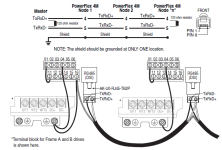Hi All
My issue is with an MSG error code 37 - 'Message timed out in local processor' between an ML1400 and 8 Powerflex 4M's. When the VSD's are stopped the MSG functions work without error and as expected but when one or more of the drives are running some of the MSG's error. There is no pattern to which ones error and which do not, but generally more than 50% to 100% of the MSG's error on each cycle. Initially I suspected electrical noise on the 485 coms but now I'm not so sure The coms cable has been updated to Belden 9842 from standard screened cable and rerouted, but to no avail. The network setup is in line with AB manuals and good screening practice. Regardless of any changes in setup and layout the issue remains the same.
The 8 PF4m's are in a separate stainless steel panel to the plc and the power cables from the VSD's are routed directly from the drive panel to the motors without passing back through the plc panel.
Initial setup:
Start Source =5 Comms Port
Speed Ref = 5 Comms Port
Comms Data Rate = 4 (19.2 K, and is matched with my program configuration)
Node Address = 1 to 8 (Unique address)
Comms Format = 0 RTU 8 N -1
Because of unreliable stop commands as a result of the errors, run commands are now hard wired and the drive setup as follows
Start Source =2 - 2 wire
Speed Ref = 5 Comms Port
Comms Data Rate = 4 (19.2 K, and is matched with my program configuration)
Node Address = 1 to 8 (Unique address)
Comms Format = 0 RTU 8 N -1
Status MSG's are in a separate file to command MSG's
A bit frustrated so any suggestions appreciated
My issue is with an MSG error code 37 - 'Message timed out in local processor' between an ML1400 and 8 Powerflex 4M's. When the VSD's are stopped the MSG functions work without error and as expected but when one or more of the drives are running some of the MSG's error. There is no pattern to which ones error and which do not, but generally more than 50% to 100% of the MSG's error on each cycle. Initially I suspected electrical noise on the 485 coms but now I'm not so sure The coms cable has been updated to Belden 9842 from standard screened cable and rerouted, but to no avail. The network setup is in line with AB manuals and good screening practice. Regardless of any changes in setup and layout the issue remains the same.
The 8 PF4m's are in a separate stainless steel panel to the plc and the power cables from the VSD's are routed directly from the drive panel to the motors without passing back through the plc panel.
Initial setup:
Start Source =5 Comms Port
Speed Ref = 5 Comms Port
Comms Data Rate = 4 (19.2 K, and is matched with my program configuration)
Node Address = 1 to 8 (Unique address)
Comms Format = 0 RTU 8 N -1
Because of unreliable stop commands as a result of the errors, run commands are now hard wired and the drive setup as follows
Start Source =2 - 2 wire
Speed Ref = 5 Comms Port
Comms Data Rate = 4 (19.2 K, and is matched with my program configuration)
Node Address = 1 to 8 (Unique address)
Comms Format = 0 RTU 8 N -1
Status MSG's are in a separate file to command MSG's
A bit frustrated so any suggestions appreciated





